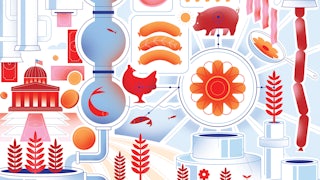Bruce Friedrich beamed as he took the lectern at the inaugural Good Food Conference. It was September 2018, and as president and founder of the Washington, D.C.–based Good Food Institute, Friedrich was one of the leading voices advocating for alt-meat. Nearly 500 people had gathered at the University of California, Berkeley, including the biggest names in cellular agriculture—the would-be disrupters who envisioned slaughterhouse meat replaced with cuts made from the cells of cows, chickens, pigs, and fish.
“We need a new agricultural revolution,” Friedrich announced. “That revolution is right here, right now. It’s in this room.”
At the same time that these upstarts extolled the potential for metamorphosis in America’s meat industry, the companies and organizations that own it were preparing for a fight. Nearly six months before that Berkeley confab, one Big Ag group had filed a federal petition asking that the terms “beef” and “meat” be reserved exclusively for products from companies that don’t make meat from cells.
In the Berkeley conference center hall, the innovators hoping to displace pastures with laboratories were preparing for the day of their inevitable showdown with the existing industry. In order to make sure their revolution wasn’t blocked by the incumbent lobbying forces of Big Ag, they asked themselves, do we need to team up?
If companies engineering meat and poultry from cells are still overcoming technological hurdles, their eventual triumph appears more likely with each passing month. Less than three years ago, the world’s first commercially available lab-grown chicken from California-based Eat Just hit restaurants in Singapore, the only country to date to approve such meat for commercial sale. But the United States doesn’t seem far behind. Last November, Upside Foods, another California company, received the first-ever “No Questions” letter from the Food and Drug Administration, which agreed with the company’s conclusion that its cellular chicken was safe to eat.
Observers of the field argue that cell-based beef and chicken will enter stores this decade. Planning for this eventuality raises important questions: Will people know what they’re buying? Will the laws that govern the sale of farm-raised meat be the same for cell-based meat? In March, the FDA sent the same “No Questions” letter to Eat Just about its cell-based chicken.
For the various companies developing cell-based ag, the answer in 2018 was clear: If they didn’t come together to address such questions, they could get hurt further down the line. Over the next year, in Slack chats and weekly conference calls, they created a coalition that could pave the way for cellular disruption of the meat market. Today the Association for Meat, Poultry and Seafood Innovation, or AMPS Innovation, is the first special-interest group in Washington, D.C., to represent the field of cellular agriculture. It counts nine members so far, including Upside Foods and Eat Just.
The group, as a formal trade association, has a manifold mission. Public education and outreach—explaining cellular agriculture to consumers and elected officials—are part of it. But the biggest challenge for these would-be rivals is around the corner, as federal agencies assemble the regulations to manage cell-based methods for producing beef, poultry, pork, and seafood. Grabbing a seat at the table as policymaking begins is a foremost concern for the companies making up the new coalition. As they’re all too well aware, Big Ag is a force inside the Beltway: Tyson Foods alone spent $1.8 million last year on lobbying, compared to AMPS Innovation’s paltry $20,000. Speaking as one voice, it’s thought, will guarantee these newcomers more of a say in the policymaking process. “It’s much more effective,” said Josh Tetrick, CEO of Eat Just. “It just comes off as much more credible when you’re speaking as a collective as opposed to speaking as a single company.”
Cell-based meats (the industry’s preferred term is “cultivated” meat) are wholly unlike the more familiar plant-based offerings that proliferated over the past decade. Companies like Beyond Meat or Impossible Foods mix soy or pea proteins with other ingredients to mimic the taste and mouthfeel of real meat. Scientists at cultivated-meat companies, however, create their products from animal cells, not animal carcasses. That work takes place inside bioreactors, production chambers precisely calibrated for cells to multiply into muscle fibers. A burger made of ground beef product from a culture of cow cells is real meat—it just came from a facility that looks more like a brewery than a slaughterhouse.
So far, that process results in a much pricier product, although the numbers seem to be trending in the right direction. A few years ago, a single chicken nugget produced by Good Meat, the cell-based subsidiary of Eat Just, cost about $50. Today in Singapore, a restaurant dish with Good Meat’s chicken might go for $17. (Not bad, considering the cost of a beef burger in many cities these days.) It’s expected that prices will continue to fall as the technology improves, and as the costs fall, more people seem inclined to give cultivated products a chance, for a variety of reasons: animal welfare, the dangers to workers in processing plants, a continued threat of zoonotic viruses. “You can look at it through the eyes of compassion,” Tetrick said. “You can look at it through the eyes of food safety. You can look at it through the lens of economics. Personally, I want to live in a world where the majority of meat that’s consumed doesn’t require the slaughter of an animal.”
Following the current regulatory split proposed by federal agencies, the FDA will subject cultivated-meat companies and their products to the same food safety standards as other meat, poultry, and seafood currently on the market. The final word on labeling requirements then rests with the U.S. Department of Agriculture. (The one exception: Labeling for cell-based seafood falls within the purview of the FDA.) According to a spokesperson with USDA’s Food Safety and Inspection Service, a proposed rule on labeling cultivated-meat products could arrive as soon as August.
What it comes down to is a fundamental interpretation of the nature of the protein on people’s plates, and whether meat made from cells will be considered the same as meat raised on the farm. Members of the D.C. “barnyard”—some of the biggest organizations representing farm-raised meat—are already insisting it’s crucial to delineate their products from meat nursed into being by science. “There should be some sort of labeling requirement that says it was developed in vitro, or in a petri dish, or in a lab,” Lia Biondo, executive vice president of the U.S. Cattlemen’s Association, told me. “We’ve spent decades building up an incredible brand, and we don’t think this other product should be able to ride on the coattails of that.” The USCA wrote the letter to the USDA in early 2018 asking that the terms “meat” and “beef” be reserved for slaughtered animals. The department denied the petition, but Biondo insists it “kick-started” a conversation: “We still hold out that these products should not be called ‘meat.’”
Policymaking in D.C. tends to favor the established folks with entrenched lobbyists. Such a situation can be unfavorable to the cell-based businesses looking to influence the rules that, depending on how they’re crafted, could spell doom or bloom for the cultivated-meat industry. “There are various ways in which Big Meat could squash its competitors,” said Jennifer Jacquet, associate professor in the department of environmental studies at New York University. “One way is gobbling them up. The other is to litigate and make their life miserable and their expenses much higher and their products not marketable.”
Keenly aware of this dynamic, the competitors-turned-compatriots of AMPS Innovation would rather be at the table than on the menu. And yet their move to band together into a trade association, they say, wasn’t done to psych themselves up for a showdown with conventional meat producers. The association views cultivated products as complementary to what Big Ag already produces. Some of those behemoths are even investors in cultivated meat: Tyson Foods, for instance, took a minority stake in Upside Foods in 2018.
What these newcomers proposing to package meat made in labs recognize, instead, is that federal guidelines can sometimes be a silent killer of new industries. Moving fast and breaking things might work if you’re interested in skirting taxicab regulations, but it doesn’t exactly work in the world of food.
Eric Schulze, a vice president at Upside Foods and chair of the association’s regulatory affairs committee, said the goal for AMPS is to have a clear viewpoint on guidelines and safety standards. Right now, the member companies want a voice in D.C. to make sure they’re communicating the relevant aspects of their industry to officials in the FDA and USDA—so that the entire cellular agriculture industry can accelerate its push to market without circumventing any forthcoming rules. Cell-based meat makers, Schulze said, want to be regulated like the rest of the food industry, with the same sorts of food safety expectations and practices in place.
And yet, in the end, much of the lobbying work AMPS Innovation will have to do comes down to the label. It’s not too dissimilar from the battle over what to call alternative milks. In February, the FDA published a draft proposal stipulating that oat, almond, and other plant-based milks can call themselves milk, with the added recommendation that they also label the nutritional differences between their products and cow’s milk. The question isn’t quite the same, though, since oat milk is entirely different from cow’s milk, whereas, from the consumers’ perspective, the final product of cellular meat should be largely indistinguishable from the meat they’re used to eating.
Still, the new industry largely agrees that customers have a right to know the origins of what they’re buying and that their products should be labeled differently. The real issue is how best to describe that difference. Does the word “cultivated” go before the word “beef”? Or is there simply a description on the label of how cell-based meat, poultry, pork, and seafood came to be?
“The word ‘cultivated’ or ‘cultured’ or whatever term the U.S. government allows us to adopt is important to have,” Schulze said. “The horse-trading, if you will, is around whether the term would discourage a consumer.”
At the state level, that battle has been playing out for a few years already. Egged on by local farm bureaus and cattle ranchers, state lawmakers are passing legislation circumscribing the wording cultivated-meat startups may use. An Alabama law passed in 2019, for example, says that any “food product that contains cultured animal tissue produced from animal cell cultures … may not be labeled as meat or a meat food product.” But Schulze, who cut his teeth at the FDA regulating novel foods before jumping to the private sector, rests easy on this point. “State label challenges are almost never upheld,” he said. That’s because the USDA will have to approve the label of something like cultivated chicken before it ever goes into stores—making a clear set of guidelines all the more important for the companies of AMPS Innovation.
Over the coming decade, as cell-based meats maneuver their way into grocery stores, it will all come down to that moment when a person picks up a package and reads the cellophane wrapper. During a panel at the Good Food Conference in 2018 where AMPS first got its start, Upside Foods CEO Uma Valeti was direct. “There’s no need for a prefix. There’s no need for it to be ‘cell-based,’” Valeti said. “It’s meat, plain and simple.”






